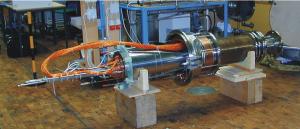HTS technology leads the way
25 Mar 2011
-
Pierre Bauer, Superconductor Systems and Auxiliaries Section
Current leads are the components that transmit the large currents from room-temperature power supplies to very low-temperature superconducting coils. The current leads for the ITER Tokamak have come a long way: from the original 60 kA proposals from the Japan Atomic Energy Research Institute (JAERI) and European partners (KIT's "demonstrator"), to the first prototypes fabricated and tested in China at the Chinese Academy of Sciences, Institute of Plasma Physics (ASIPP), and on to the presentation of the final design at the ninth High Temperature Superconductor (HTS) working group that met at Cadarache this week.
The HTS working group, which brings together experts from institutes in Japan (NIFS), Europe (KIT, CERN), China (ASIPP) and the ITER Organization, has been supporting the development of the HTS current leads for ITER since 2008. The current lead designs presented this week were fully endorsed by the working group, an endorsement crowning not only the ITER Organization's recent efforts, but also the significant investment by ASIPP/China in the fabrication and testing of four current lead pre-prototypes over the last three years.
The "demonstrator", a 70kA HTS current lead, produced at the Karlsruhe Institute of Technology (Photo courtesy:EFDA)
It did not take long after the discovery of High Temperature Superconductors (HTS) in the 1980s for engineers to realize that HTS would permit significant reduction in the heat conducted into cryogenic systems through current leads. This is a particularly pertinent discovery for ITER because of the expense of removing heat at the liquid-helium temperatures at which the ITER magnets are operated.
HTS current leads use a short segment of HTS that can sustain much higher current-densities than even good conductors such as copper, allowing the reduction of the material cross-section and the related heat conduction by about tenfold. In ITER, where 60 current leads transfer a staggering 2.7 MA (MegaAmperes) into—and out of—the cryostat, conventional current leads without HTS would conduct approximately 1W/kA into the cryogenic system. This represents approximately 20 percent of the total heat extraction capacity of the cryoplant that will be installed in ITER.
For the design of the ITER HTS current leads, the ITER Organization has chosen a safe approach. Due to the unprecedented scale of these leads both in current (68 kA for the TF coil feeders) and voltage (30 kV), an effort has been made to adopt proven concepts wherever possible. Also, the design had to be completed within a tight schedule and with limited resources. For this effort, the HTS working group played a crucial role, bringing together experience from other projects that use superconductivity on a large scale, such as EAST, LHC, LHD and W7X. Major features of the design are derived directly from the successful CERN development undertaken for the more than 1000 HTS current leads that were built for the LHC.
HTS current leads use a short segment of HTS that can sustain much higher current-densities than even good conductors such as copper, allowing the reduction of the material cross-section and the related heat conduction by about tenfold. In ITER, where 60 current leads transfer a staggering 2.7 MA (MegaAmperes) into—and out of—the cryostat, conventional current leads without HTS would conduct approximately 1W/kA into the cryogenic system. This represents approximately 20 percent of the total heat extraction capacity of the cryoplant that will be installed in ITER.
The factor 2 increase in the cost of current leads due to addition of (still relatively expensive) HTS material is more than offset by the cost savings for cryoplants and power savings during operation. Most importantly, HTS current leads—in a similar way to superconducting magnets—contribute to the positive energy balance of the ITER Tokamak. They are thus a minor, but crucial element of a tokamak ... that is, if you can call a 3-metre-long object that weighs half a ton and carries 68 kA "minor."
For the design of the ITER HTS current leads, the ITER Organization has chosen a safe approach. Due to the unprecedented scale of these leads both in current (68 kA for the TF coil feeders) and voltage (30 kV), an effort has been made to adopt proven concepts wherever possible. Also, the design had to be completed within a tight schedule and with limited resources. For this effort, the HTS working group played a crucial role, bringing together experience from other projects that use superconductivity on a large scale, such as EAST, LHC, LHD and W7X. Major features of the design are derived directly from the successful CERN development undertaken for the more than 1000 HTS current leads that were built for the LHC.
More news will follow when the ITER current lead designs are qualified in ASIPP/China in mid-2012.



